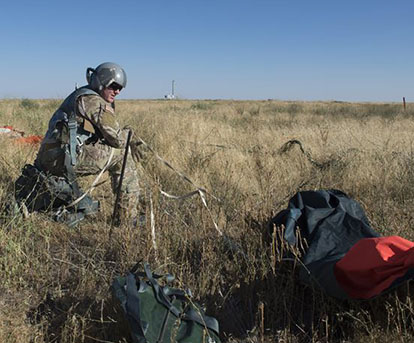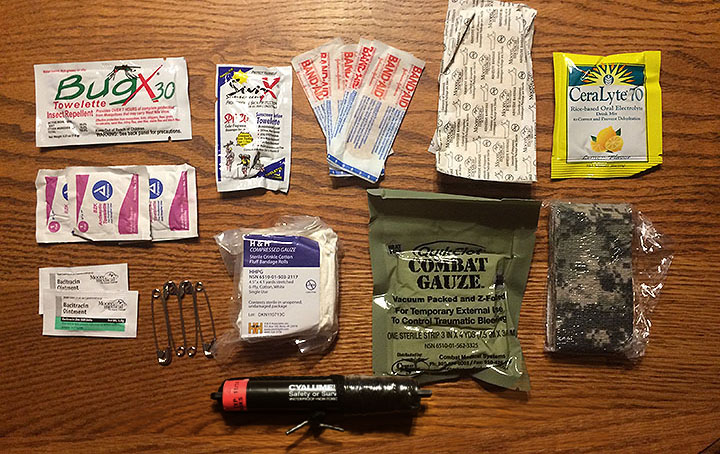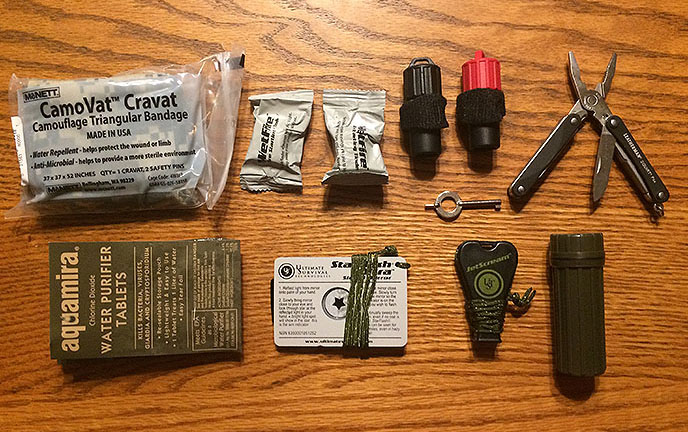
Preppers build their survival kits based on what they anticipate needing if SHTF. So, when a friend gave me a set of USAF Survival Modules, I was intrigued to see what the Air Force thought their air crew would need, and why.

The USAF kit actually comes in two modules: #6545-01-534-0925, the medical module, and #6545-01-534-0935, the survival module. Both come vacuum sealed in waterproof plastic packs, each with a grommet so the airman can clip it to himself. After all, if he’s in a bail-out situation, his hands will be occupied with his parachute. Within each pack is a zip-lock bag (no longer water-tight. Each has little holes)
Here’s what is in each:
Medical Module — 0925

1 – Combat QuikClot bandage: 3” x 4 yards
4 – 2” (pad size) adhesive bandages
4 – 1” wide adhesive bandages
1 – Compressed Gauze. Un-vacuum-sealed: 4.5” x 4.1 yards
1 – 2”-wide camo wrap tape
2 – Bacitracin ointment packs (1 g. each)
4 – Antiseptic towelettes
1 – Electrolyte pack (mix with 7 oz. water) to prevent dehydration from diarrhea.
1 – BugX30, insect repellant towelette. Good for 7 hours
1 – SunX SPF30+ sunscreen, 1/4 oz.
4 – Large safety pins
1 – Cyalume IR glow stick (in hard plastic case, w/lanyard)
Survival Module — 0935

1 – Leatherman Squirt multitool
1 – CamoVat Cravat: 37 x 37 x 52” triangle (digital camo)
10 – Aquarmira water purification tablets (each tablet to treat 1 liter)
1 – Waterproof match case, which contains:
10 stormproof matches with striker strips
1 Spark-lite flint wheel
1 Button compass
(The cap of the match case has a small mirror. The bottom of
2 – WetFire tinder packs
1 – Finger flashlight with red LED (3 button cell batteries)
1 – Finger flashlight with IR LED
1 – JetScream whistle
1 – StarFlash signal mirror
1 – Handcuff key
As Jack of Black Scout Survival pointed out in his YouTube review of the USAF kit, the two important things NOT in the kits are cordage and shelter. He reminds everyone that an airman who bailed out will have his parachute — essentially a huge tarp and all the paracord he could want.
Impressions on Design: Medical Module
The medical module is geared toward treating small wounds and stopping the bleeding. The bandages are small: the antiseptic quite limited. The Air Force anticipates that their downed airman maybe be hurt but will be mobile. Their goal, as we’ll see in the Survival Module, is to extract the downed crewman. They are expecting mobility. The Air Force is not equipping each airman with a major trauma, field surgery kit.
The sundries also speak more to temporarily adapting to ground conditions — sunblock, insect repellant, anti-diarrheal electrolytes.
Impressions on Design: Survival Module
The usual go-to first item in peoples’ survival kits — a weapon — is assumed to be on the airman already. Some of the items speak to anticipating some evasion and escape, such as the camo cravat, red flashlight (map reading: assuming night travel), compass and the handcuff key.
Some items fall into the customary survival tools categories of fire and water. The multitool is pretty neat, given its size. The match case has ten matches and the spark-lite wheel. There is also a very small ferro rod glued to the bottom. It won’t make many sparks, but it can make a few. They give each crewman water treatment tablets to treat ten liters: several days worth of water but not enough to cross the Gobi Dessert. There is no water container. The Air Force assumes each man will bail with a canteen, or they expect him to scrounge up a container wherever he is.
Designed for rescue
The rest of the items are designed for rescue: the signal mirror, the whistle, the IR flashlight and IR glow stick. Obviously, the Air Force anticipates that if they have a man down in hostile territory, there will be a sizable group of men and machines searching for him, hoping to rescue and extract him. Much of the Survival Module seems designed around getting the man to an extraction point and signaling that he’s there.
There are no food items of any kind. No snares, no fishing kit, no break-out arrowheads for hunting small game. The airman is assumed to be always mobile and headed toward some extraction point, not hunkered down or foraging for food.
Compare and Contrast
When I look at the “survival kit” I’ve made up for myself, there are many similarities. I have the fire kit, the water kit and since I don’t have the parachute, I have cordage and some tarps. I have a basic medical kit too. Like the Air Force, it is not a field-surgeon’s kit loaded out to treat multiple gunshot wounds. It covers minor to medium injuries.
For contrast, I do not anticipate there being a platoon of friendlies looking to rescue me. Almost all of my travel (commutes, business trips, etc.) are fairly near civilization. If I’ve gone missing (crashed in the woods), I won’t be miles from travelled routes. I anticipate having to survive a few days in the bush, but do expect that someone will come looking for me fairly soon. I’ll stay near the vehicle.
On the other hand, part of my kit (the Get Home Bag) as an assumption that if things get bad enough that I need to “Get Home” from work, I might need to conceal myself rather than be easy to spot. That is why I’ve chosen camo-pattern tarps and an olive green Tact Bivy rather than the bright orange one. There won’t be a Blackhawk and crew trying to rescue me. I expect to be on my own.
Summary
We all recognize that our own Survival Kits or Get Home Bags are compromises. They cannot contain every item we might possibly need. If we did, we’d all have 100 lb. bags and not get very far. Instead, we make choices of what can go and what must stay. Those decisions are built around what we anticipate our needs will be.
What assumptions did YOU make when you assembled your survival kit? We can see what the Air Force assumes.
